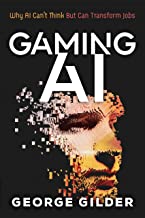Could Carbon Computing Make Computers More Environment Friendly?
As a key component of life forms, carbon is abundant and energy efficientCarbon, a very abundant chemical element, is one of the building blocks of life, partly on account of its stability. It is a minimalist element, compared to the silicon used in computing today:
… carbon dioxide is is a small gaseous molecule consisting of two oxygens both forming a double bond with a single carbon while silicon dioxide is a massive behemoth of a molecule made of huge numbers of alternating oxygen and silicon atoms and is more commonly known as sand.
S. E. Gould, “Shine on you crazy diamond: why humans are carbon-based lifeforms” at Scientific American (November 11, 2012)
But there’s something else about carbon. As George Gilder puts it, carbon-based life forms, like humans, consume very little energy while “computing”:
If you take the whole global internet, until a couple of years ago, to map all the connections in the global internet, it took about a zettabyte, that is 10 to the 21st power.
And how big do you think the connectome of one human mind is? It’s about a zettabyte. In other words, one human brain is about as densely and complexly connected as the entire global internet. But one human brain functions on 12 to 14 watts of energy, while the global internet takes gigawatts of energy, billions of watts.
News, “Has the singularity been called off? Indefinitely postponed?” at Mind Matters News
So yes, silicon works but no, it is not energy efficient. That’s why, to meet energy efficiency goals, some researchers are working on methods of carbon computing, for example, a metallic wire made entirely of carbon, which “could give computers a massive power boost, allowing for devices to potentially hold a charge for months.”
Some headway has already been made in working with carbon:
From organic solar cells (OSCs) to organic light-emitting diode (OLED) displays, many carbon-based electronics have already entered the market. In fact, some of them represent a multi-billion dollar industry and now rival their silicon predecessors thanks to their low manufacturing costs and eco-friendly nature.
Olawale Daniel, “Carbon-Based Computing: 4 Exciting Developments in Organic Electronics” at TechAtLast (March 22, 2019)
Last year, engineers built a working computer chip out of carbon nanotubes, an important proof of concept that was published in Nature.
In last week’s podcast, futurist George Gilder and computer engineer Robert J. Marks looked at, among other things, what’s really happening with carbon computing:
(The discussion of carbon computing begins at 18:16)
Robert J. Marks: I know you’re an early proponent of carbon computing. The idea is really compelling because the computational part of human beings is definitely carbon-based, but we haven’t gone there, have we? We’re still in silicon. What’s going on in carbon computing, and what do you see as the future of it?

George Gilder (pictured): Silicon is popular because it’s simple, and because it yields these very rapid computations with binary systems, on, off codes, ones and zeros, and ones and zeros can be manipulated at fabulous speeds. That’s why the whole computing revolution happened, because you could really manipulate symbols at a tremendous speed. But the cost of this, is the symbols got to be translated into objects.
Well, carbon is much more complex and affords many more degrees of freedom in materials and shapes. We’re beginning to make memories and simulate behavior with carbon nanotubes and filter with them. Many of our computer screens are carbon based now.
And so carbon is gradually moving into the computational world. In order to make any real long-term advances in computation, rather than grasping for elusive quantum superpositions, you can actually simulate the brain of a fly in carbon.
We don’t even understand how a brain of a fly allows it to elude the swatter. The world is more mysterious than the advocates of the Singularity imagine.
Note: Many people might be surprised to learn that if computers thought like fruit flies, they could do more: “Recently, researchers discovered that fruit flies use a filter similar to a computer algorithm to assess the odors that help them find fruit, only the flies’ tools are more sophisticated.” And that’s carbon-based computing, if you like.
Robert J. Marks: One of the stories I like to share is an old science fiction story about why humans by necessity must be carbon-based. And that is because we breathe in oxygen and we exhale carbon dioxide. If we were made of silicon, we would breathe in oxygen and exhale silicon dioxide, which is a solid. We would be crushed by our own breath when we slept at night. So, according to the story, that’s the reason that we are carbon-based as opposed to silicon-based.
George Gilder: That strikes me as intelligent, in its design.

The podcast addressed a number of themes from Gilder’s Gaming AI ( free for download here). In the book, he says,
In operations per watt, the prevailing champion is made not of silicon but of carbon. It is the original neural network, the human brain and its fourteen watts, which is not enough to illuminate the incandescent light bulb over a character’s head in a cartoon strip. In the future, computers will pursue the energy ergonomics of brains rather than the megawattage of Big Blue or even the giant air-conditioned expanses of data centers. All computers will have to use the power-saving techniques that have been developed in the battery-powered smartphone industry and then move on to explore the energy economics of real carbon brains. (p. 45)
We do need alternatives. Many internet users don’t realize that the “cloud” in cloud computing is not a vague, ethereal atmosphere. It is miles of “huge data centers, all parked by bodies of water to take off the immense heat generated. It’s hardly sustainable now and won’t get any more so if it just keeps growing. Carbon, by contrast, has been an information storage source with low energy consumption since the origin of life on Earth.
Also discussed in last week’s podcast:
Does Schrödinger’s cat think quantum computing is a sure thing? It might lead to more security, though not to thinking computers. Quantum computing means computing directly with quantum elements, thought to underlie all matter in the universe. In theory, it will be faster and safer.
and
While the West hesitates, China is moving to blockchain. Life After Google by George Gilder, advocating blockchain, became a best seller in China and received a social sciences award. George Gilder, also the author of Gaming AI, explains why Bitcoin might not do as well as blockchain in general, as a future currency source.
You may also enjoy: Will quantum mechanics produce the true thinking computer? Quantum computers come with real world problems of their own.
